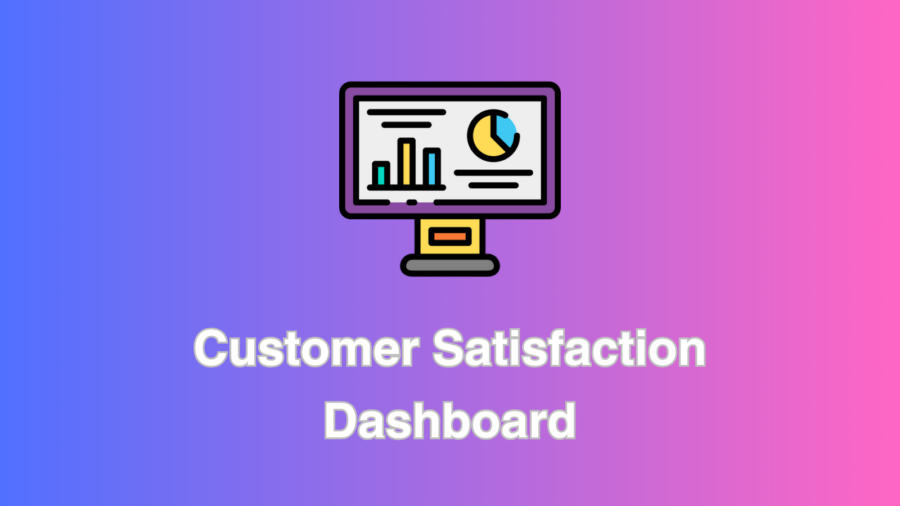Understanding and optimizing customer satisfaction is paramount for sustained success. This is where the Customer Satisfaction Dashboard comes into play, acting as a powerful tool to gauge and enhance customer experience. A Customer Satisfaction Dashboard visually represents key metrics and insights that provide a holistic view of customer sentiment and engagement. In this blog post, we will delve into the significance of Customer Satisfaction Dashboards, the step-by-step process of creating one, and how product managers can leverage these insights for informed decision-making.
Why Customer Satisfaction Dashboards Matter
Customer Satisfaction Dashboards serve as a compass, guiding businesses towards customer-centric strategies. These dashboards amalgamate data from various touchpoints, such as surveys, social media, and support interactions, to offer a consolidated view of customer satisfaction levels. Tracking and analyzing this data in real time empowers businesses to respond swiftly to emerging trends and issues. A well-designed Customer Satisfaction Dashboard is not just a visual aid; it’s a strategic asset that fuels data-driven decision-making.
Creating Your Customer Satisfaction Dashboard
Building an effective Customer Satisfaction Dashboard requires careful planning and consideration of key elements. Here’s a step-by-step guide to help you create a dashboard that not only meets your business needs but exceeds customer expectations:
- Define Key Metrics:
Start by identifying the key performance indicators (KPIs) that align with your business goals. These could include Net Promoter Score (NPS), Customer Satisfaction Score (CSAT), and Customer Effort Score (CES). Clearly define what success looks like for each metric. Customer Satisfaction Dashboard: Now that you’ve established your key metrics, it’s time to incorporate them into your dashboard. - Choose a Data Visualization Tool:
Select a data visualization tool that suits your requirements. Popular choices include Tableau, Power BI, and Google Data Studio. These platforms offer user-friendly interfaces and a wide range of visualization options. Customer Satisfaction Dashboard: Ensure that the chosen tool easily integrates diverse data sources, providing a comprehensive view of customer satisfaction. - Gather Data from Multiple Sources:
Customer feedback comes from various channels, such as surveys, social media, and customer support interactions. Integrate these diverse data sources into your dashboard for a holistic representation of customer sentiment. Customer Satisfaction Dashboard: The amalgamation of data sources is the backbone of a robust Customer Satisfaction Dashboard. - Design a User-Friendly Interface:
Keep the dashboard design simple and intuitive. Use charts, graphs, and heat maps to convey information visually. Ensure the interface is accessible to all stakeholders, not just data experts. Customer Satisfaction Dashboard: A user-friendly interface enhances accessibility, allowing stakeholders to interpret and act upon the insights presented easily. - Implement Real-Time Updates:
Enable real-time updates to ensure your dashboard reflects current customer feedback. This feature allows businesses to respond promptly to emerging issues and capitalize on positive trends. Customer Satisfaction Dashboard: Real-time updates transform your dashboard into a dynamic tool that adapts to the ever-changing landscape of customer sentiment.
Leveraging Customer Satisfaction Insights for Product Managers
Product managers play a pivotal role in shaping the customer experience, and a Customer Satisfaction Dashboard can be their trusted ally in this endeavor. Here’s how product managers can make the most of the insights derived from these dashboards:
- Identify Product Improvement Opportunities:
Analyzing customer feedback on the dashboard provides valuable insights into areas where product improvements are needed. Whether addressing specific pain points or enhancing existing features, product managers can prioritize their efforts based on real-time data. Customer Satisfaction Dashboard: Pinpoint areas for improvement and innovation by closely examining customer feedback on your dashboard. - Track Feature Adoption and User Engagement:
The dashboard allows product managers to monitor the adoption rates of new features and understand how users engage with the product. This information is crucial for optimizing the user experience and ensuring product updates align with customer expectations. Customer Satisfaction Dashboard: Keep a close eye on feature adoption and user engagement metrics to fine-tune your product strategy. - Benchmark Against Competitors:
Comparative analysis is a powerful tool for product managers. By benchmarking your customer satisfaction metrics against industry competitors, you can identify areas where your product excels and requires attention. Customer Satisfaction Dashboard: Gain a competitive edge by using your dashboard to benchmark your customer satisfaction metrics against industry standards. - Predict and Prevent Customer Churn:
Proactive customer retention is vital for sustainable growth. Product managers can take preemptive measures to address issues and prevent churn by identifying customer feedback patterns that indicate dissatisfaction. Customer Satisfaction Dashboard: Use predictive analytics to stay one step ahead of potential churn by identifying and resolving issues before they escalate.
Real-World Examples
To illustrate the impact of Customer Satisfaction Dashboards, let’s look at a couple of real-world examples:
- Company A’s Turnaround:
Company A, facing a decline in customer satisfaction, implemented a Customer Satisfaction Dashboard. They identified specific pain points in their customer support process through real-time monitoring. By swiftly addressing these issues, they improved customer satisfaction and witnessed a significant increase in customer loyalty. Customer Satisfaction Dashboard: Company A’s success story underscores the transformative power of a well-utilized Customer Satisfaction Dashboard. - E-Commerce Giant’s Product Enhancement:
An e-commerce giant utilized its Customer Satisfaction Dashboard to track customer feedback on its mobile app. By analyzing user comments and ratings, the product team identified a recurring issue with the checkout process. Implementing a streamlined checkout system based on these insights resulted in a notable boost in overall customer satisfaction. Customer Satisfaction Dashboard: This example showcases how granular insights from the dashboard can drive specific improvements, leading to enhanced customer satisfaction.
In conclusion, the Customer Satisfaction Dashboard is not just a visualization tool; it’s a strategic imperative for businesses looking to thrive in the customer-centric landscape. Product managers can steer their organizations toward continuous improvement and customer delight by following a structured approach to creating a dashboard and leveraging the insights gained.
Remember, the Customer Satisfaction Dashboard is not a one-time project but an evolving asset that adapts to changing customer preferences and market dynamics. Embrace the power of data, and let your Customer Satisfaction Dashboard be the compass guiding your journey to customer-centric success.





